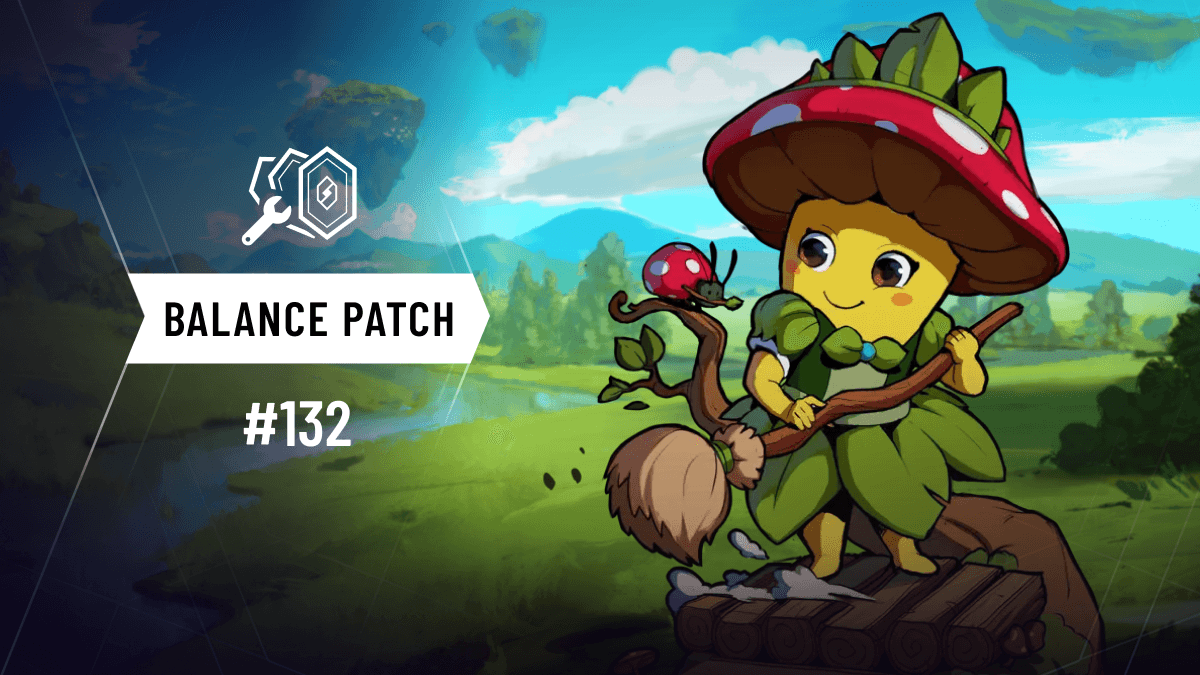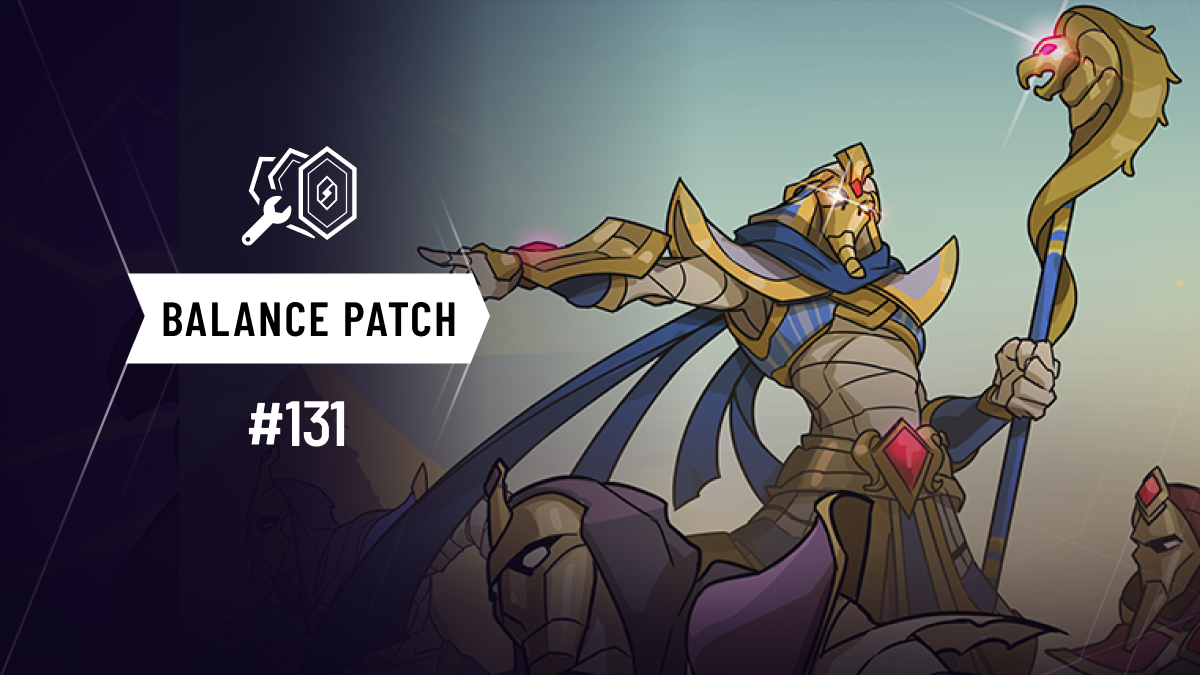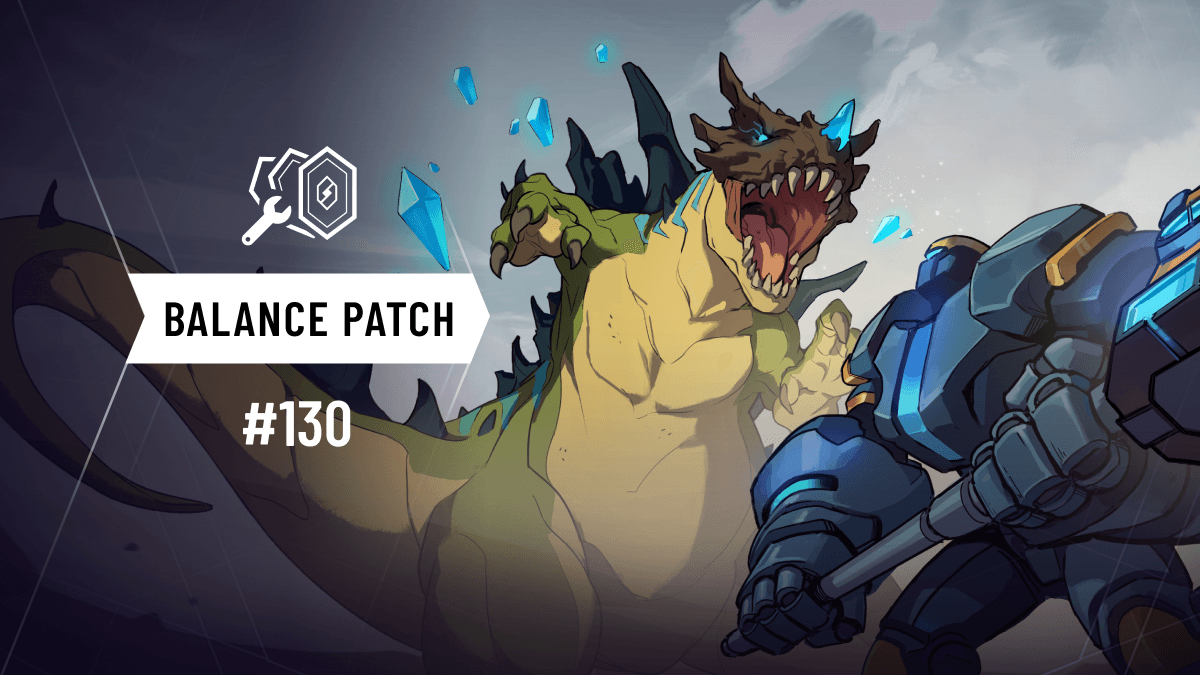Market Overview
An open economy means there are no limits on the ways you can trade. Some blockchain games claim to have open markets but impose restrictions on which markets you can participate in. And, most traditional games don’t let you trade at all. In Skyweaver, you can truly own your game items. Trade, sell, buy, gift, and even destroy your items anywhere and anytime you want.
To drive this mission forward, we developed an open protocol for the peer-to-peer exchange of game items that is accessible right in the game! Of course, you don’t have to use it, but we think you’ll like the features it can unlock for you as a player, and enjoy what it has to offer compared to other markets. 😄 So let’s dive in!
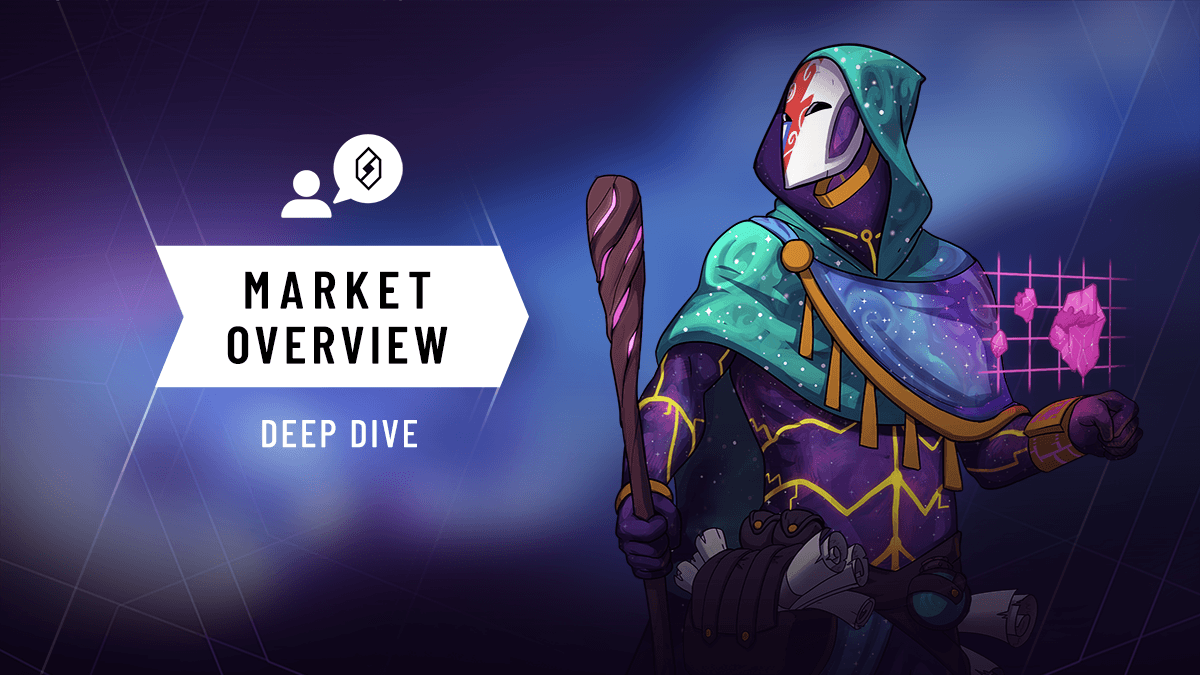
The Skyweaver Market makes trading your cards easy. The intuitive gamer-friendly interface combined with open-source blockchain technology developed by Horizon empowers players to participate in a virtual economy that is owned by everyone. The goal with our Market is to make it as simple and cost-effective as possible to trade game items without compromising speed and security. This encourages all participants to rally behind the same system—as it is the most effective method of trade—which, in turn, increases efficiency.
Unlike other game item marketplaces, your transactions in the Skyweaver Market will resolve almost instantly so there's no waiting involved. The Market also takes all the guesswork out of the pricing equation: the Skyweaver Market automatically provides the current market price based on a fair and transparent formula. You don’t have to take our word for it: ask any Ethereum enthusiast to confirm the code—that’s the beauty of open-source software!
As a prerequisite, we suggest you read our Economy Overview, and Conquest Game Mode posts to learn more about the Skyweaver economy before continuing. Reading these will help you understand how Skyweaver items are minted!
So how does the Skyweaver Market work?
The Skyweaver Market does not operate on our (i.e. Horizon’s) servers, nor is it controlled by anyone. It exists within the Ethereum ecosystem and therefore operates in an open environment, free for anyone to use—including Skyweaver. When you interact with the Skyweaver Market in-game, you are actually interacting with a system we developed called Niftyswap. The Skyweaver Market is just an interface that provides easy access to this open player-driven market. This means the price of items is not determined by Horizon (a.k.a. Skyweaver developers), but instead, the item prices are determined by you, the players. In order for all of this to be extensible and decentralized, we opted to use an ERC token standard to represent our cards.
What are ERC tokens?
ERC tokens can represent virtually anything on Ethereum: A mythical sword, a prestigious badge from a legendary player, and even fiat currency like USD! To categorize different items, Ethereum developers created what are called ERC token standards. You can think of ERC like ‘WWW’ when surfing online. The number that comes after "ERC" refers to a specific standard—some of which are used to create a token.
ERC-721 are non-fungible tokens (NFTs). Every ERC-721 token is unique, which is why some creators choose to use this token standard to create digital artwork. ERC-20 is a standard for fungible tokens. As an example, the in-game currency used in Skyweaver is called USDC. This is an ERC-20 token. USDC tracks the price of the US dollar. 1 USDC is the same as any other USDC because they are not unique. In essence, ERC-20 tokens that share the same name are all identical (e.g. every USDC token is the same).
Finally, ERC-1155 is a token standard co-authored by Horizon that can be used to create fungible (currencies), non-fungible (unique digital cards, art, and items), and semi-fungible (a particular kind of item amongst a set of items) tokens. Basically, the ERC-1155 token standard that Skyweaver uses does many different things.

ERC-1155 tokens allow for more efficient trades and the bundling of transactions, which reduce costs. These optimizations provide a better experience for blockchain gamers. With Niftyswap behind the scenes, you can rest assured you’ll pay a fair price and have a seamless experience when you trade your cards in the Skyweaver Market.
What is Niftyswap?
Niftyswap is based on Uniswap, a protocol for automated token exchange on Ethereum. While Uniswap is for trading fungible assets like ERC-20 tokens, Niftyswap is a protocol for items (ERC-1155 tokens). Both are designed to favor ease of use and promote efficient trading. Most other exchanges maintain what's called an “order book” to facilitate trades. This process will be familiar to those who have ever bought or sold a digital item in-game between two players.
The Niftyswap protocol allows participants to contribute reserves of various tokens to particular markets, like a vending machine stocking up on candy bars. When a player buys a card in the Skyweaver Market, the trade is executed directly against these reserves in Niftyswap. Instead of bidding and listing, the Niftyswap protocol automatically sets a price using an automated market-making algorithm embedded in the protocol.
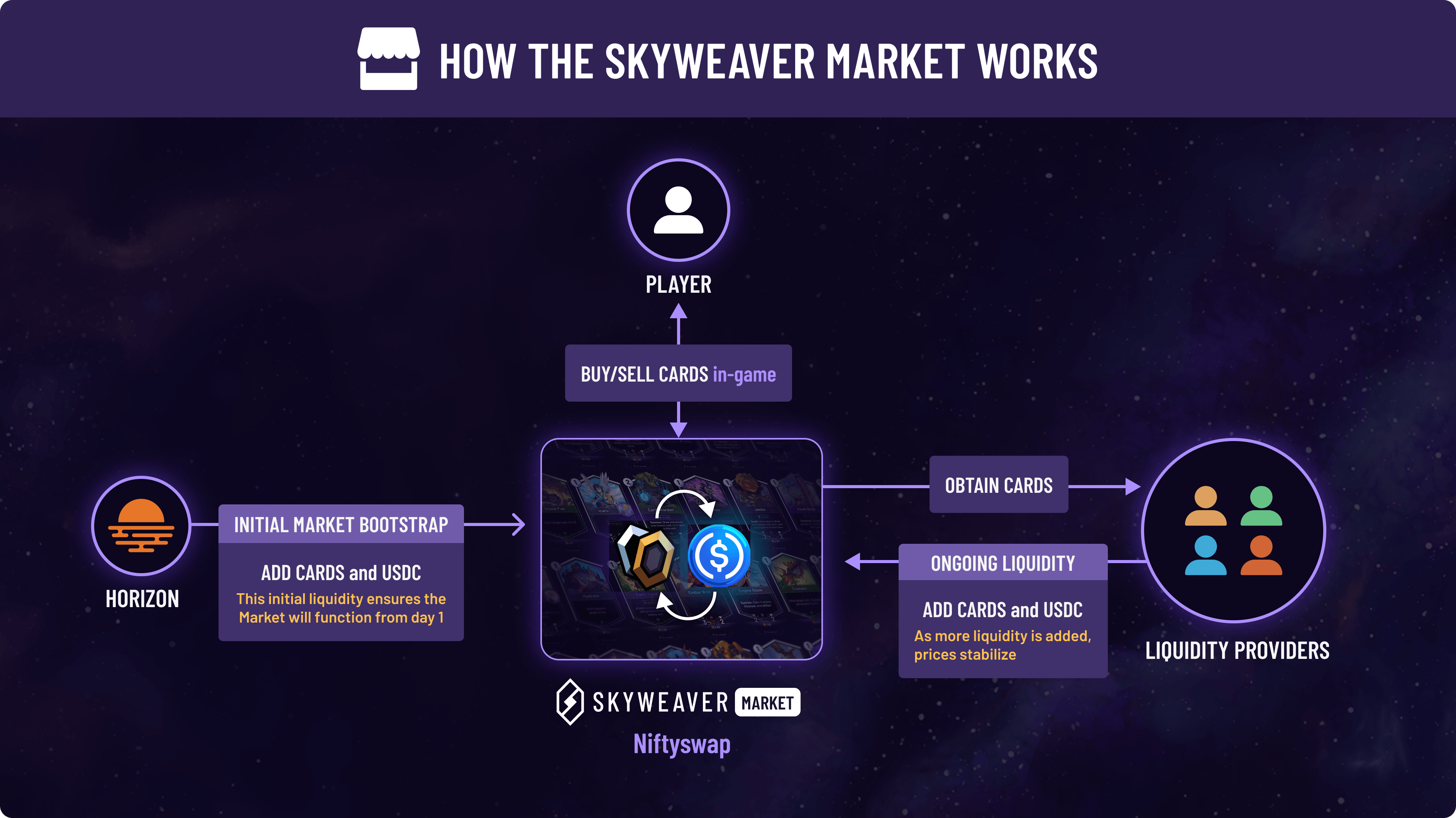
How does Niftyswap accumulate tradable Skyweaver cards in the reserve?
Reserves are pooled between liquidity providers (i.e. card owners) who supply the system with tokens. These liquidity providers can be cryptocurrency enthusiasts, decentralized finance experts, or other developers. The liquidity providers supply the Niftyswap “vending machine” with Silver cards and Gold cards. The more, the merrier! In exchange, they will receive a proportional share of Niftyswap tokens that represent their contribution—kind of like receipts. At any point, these liquidity providers can return their “receipts” to Niftyswap and request their proportionate share of items/tokens back.
It is important to note, however, they will likely receive a different amount of items in return (more on this below).
What determines the price of cards?
The price of cards is automatically calculated based on the number of cards and USDC in each vending machine “slot”. When a card owner adds a card to the Niftyswap reserve (i.e. the vending machine), they must also add another token like USDC. By doing so, the card owner creates a pairing. If the particular item has yet to be added to Niftyswap, the first person to do so determines how much USDC they would like to pair their item with.

For example, let's say someone adds 10 Starfield cards and 10 USDC. The price is automatically calculated based on the ratio between the two tokens types. So in this scenario, the price starts at ~$1.00 USD (see image above). Since anyone can add to the Niftyswap reserve, someone else can later add another 5 Starfields and 5 USDC without affecting this ratio. They cannot, however, add 5 Starfields and 2 USDC since this would change the current ratio, which would affect the price.
Why would Niftyswap suppliers receive a different amount of cards and USDC back?
Niftyswap suppliers may receive a different proportion of cards and USDC back (when they return their “receipt” tokens) because other people are interacting with the reserve. Let's say there are 10 Starfield cards and 10 USDC in the Niftyswap reserve and a player chooses to buy 1 Starfield. The player obtains the card by exchanging approximately 1 USDC, which is then added to the reserve. This means there are fewer Starfields but more USDC than before. So when the original Niftyswap supplier goes to retrieve their cards and USDC back, they instead will receive 9 Starfields and ~11 USDC.
Every additional Starfield card someone adds to their “checkout cart” will be more expensive than the previous one added. This is because more Starfield cards will be purchased (i.e. removed from the Niftyswap reserve) which will then decrease the supply available in Niftyswap. The more cards and USDC there are in the reserves, the more stable the price is for each card sold and purchased.
What is the exact formula used to determine the price of cards? (I like math) 🧮
The automated market-making algorithm embedded in Niftyswap uses this formula: x * y = k. Where x is a specific card like Starfield and y is the USDC. k is the constant used to determine the price, not the price itself. Here’s how it works:
NOTE: The word "product" here is used to describe the mathematical definition of "the result of multiplication.”
Say a supplier puts in 10 USDC and 10 Starfield cards, the product (multiplying the two numbers together; i.e. 10 * 10) equals 100. Whenever a player removes an item from the reserve (by buying 1 card, let’s say), they must maintain the original product. The total USDC multiplied by the remaining cards must equal 100. So when players try to extract 1 card from the vending machine in exchange for exactly 1 USDC, the new product becomes 99 (i.e. 9 * 11). This is clearly off-balance as the product must equal 100 in order to maintain its original state. Therefore, the player must instead place approximately 1.11 USDC into the vending machine to get 1 card. The result looks like this: 9 cards * 11.11 USDC * = ~100. That means buying 1 Starfield card will cost $1.11.
If the player takes out (i.e. purchases) an additional card—which would leave 8 Starfield cards in the reserve in total—the second transaction costs even more USDC to maintain the original state. The calculation here would be: 8 cards * 12.5 USDC = 100. After the previous trade simulated earlier, the current USDC held in the Niftyswap Starfield vending machine slot is 11.11. So the amount of new USDC the player needs to put in (i.e. spend to buy the additional Starfield card) is 12.5 - 11.11 = $1.39. Making the total cost $2.50 to acquire both Starfield cards.

Who provides liquidity to Niftyswap?
Liquidity providers are oftentimes advanced crypto users, decentralized finance experts, or other developers.
The Niftyswap protocol automatically applies a small trading fee (collected as USDC) to buyers and sellers which is distributed proportionately to those who deposited tokens in the Niftyswap reserve. Niftyswap applies this fee to encourage network participants to supply cards and USDC—for it is this supply that enables players to buy and sell cards instantly.
The Niftswap fee is another reason why people who withdraw their tokens from Niftyswap after a while will likely receive a different allocation of tokens than what they initially contributed. As players buy and sell cards, the Niftyswap fees accumulate and become part of the reserves until a supplier comes to claim their share.
📝 An additional fee will be applied upon checkout in-game on transactions completed in the Skyweaver Market.
Will there be any cards available on the Market right when Soft Launch begins?
Yes. To kickstart the Skyweaver economy at Soft Launch, Horizon will provide an initial supply of 40 copies per Silver card starting at ~1.5 USDC each and will also provide 25 copies per Gold card starting at ~10 USDC each to the Market.
Why will Horizon add liquidity?
This initial bootstrap of the Market will enable players to buy and sell Silver cards immediately without waiting for other card owners to add to the Niftyswap reserves. We believe this will provide the best user experience.
Where do these cards come from?
They are minted by Horizon in a limited fashion that restricts the amount of cards that can be minted in a given amount of time.
How did Horizon arrive at these starting prices?
For Silver cards, we referenced the price of Conquest Tickets. For Gold cards, we simply chose a number higher than Silvers since Gold cards are more difficult to obtain in Conquest.
Will you guys make revenue from this?
No. The Niftyswap “receipt” tokens Horizon obtains during this process will be burned (i.e. destroyed).
What about when new cards are released?
As new cards become available, we plan to provide initial liquidity in the same way.
What about future weekly Gold cards: will Horizon provide liquidity to these Gold cards as well?
Yes. At the start of each week, there will be 4 new Gold cards to be won via Conquest, and Horizon will supply an initial liquidity for each. Each time the in-game Conquest clock resets to signal the start of a new week, Horizon will add 25 copies per Gold card starting at ~10 USDC each. These values may change for subsequent weeks based on data we receive.
Why should you care about liquidity providers?
Well, in general, if you’re just playing Skyweaver competitively or casually for fun, you don’t really need to know all of this. However, we think that if you want to truly understand the underlying mechanics that power our Market, then it’s cool to understand the core mechanics of a game feature, or in this case, a game market feature, especially if you’ll be winning and earning a bunch of Silver and Gold cards in the game once Soft Launch begins and want to trade cards with other players.

How is Niftyswap connected to the Conquest game mode?
Conquest is where Skyweaver cards are minted! In order to ensure Niftyswap has a sufficient supply of cards, someone has to produce the cards by playing Conquest. That someone could be you, or it could be anyone across the globe! When a player completes a Conquest and emerges victorious in at least one of the three matches, they win Silver and Gold cards which can be traded on the Skyweaver Market at any time.
How does Niftyswap relate to the Skyweaver economy?
Niftyswap is an integral part of the Skyweaver economy. Without it, building up your collection would likely be cumbersome and potentially more expensive. Cumbersome because you’d have to find a buyer or seller for every item. And potentially more expensive if you forget to do your due diligence before making a buy or sell transaction (i.e. “trading” in the Market).
We believe removing these friction points will create a robust and healthy economy for Skyweaver. The ability to trade is what makes a trading card game an actual trading card game. And because you’ll be able to trade instantly with Niftyswap, winning a duplicate should feel just as exciting as winning a card you don’t already own.

How is this any different from other card games like Hearthstone, Legends of Runeterra, or Magic: the Gathering?
Skyweaver is a lot different for a number of reasons! For starters, in traditional games, you buy cards or packs from the game devs/publishers via their in-game shop or in-game store, and that’s it! You have the cards in your inventory, but you can’t trade or sell them to other players. In Skyweaver, you can add to your collection by earning cards in Conquest or Ranked Rewards and you can buy cards from other parties through the Skyweaver Market. Even from players just like you!
Once you buy these cards from the Market, you can choose to play with them, collect them, gift them, or trade them in the Market. They are your property, and you own them in your Sequence Wallet. All of this is possible thanks to the decentralized blockchain technology that powers our player-owned market and economy. In traditional games that aren’t powered by blockchain, the market and economy are effectively controlled by the game developers and game publishers. In Skyweaver, as we’ve explained in this post, you and other players shape and mold the economy through gameplay—minting Silver and Gold cards into existence simply by playing the game, ranking highly on the leaderboards, and winning Conquest matches.
Can I play Skyweaver without buying and selling anything?
Absolutely! If you have no interest in buying and selling cards, there is no need to participate in the Skyweaver Market. But if you want to gift your Silver and Gold cards to your friends, then, you must use your Sequence Wallet to do that. You can collect the entire card collection (Base version) for free in a reasonable timeframe just by playing the game and leveling up. We also have a unique game type called Discovery where both players are given a randomly generated deck of cards for every match. Not only is Discovery a great way to jump into the game and start learning, but it also offers free Silver cards just for playing! How does this work? Well, every week, the top Discovery and Constructed players on the ranked leaderboards will receive free tradable Silver cards! More info on this in our Economy Overview blog post here.
📝 During Soft Launch Horizon will pay for all network fees that occur in Skyweaver such as trading, buying, or selling. We can’t promise that we’ll cover gas fees forever, but we’ll let you know if we plan to stop.
Where can I read more about Niftyswap?
We believe decentralized trading protocols like Niftyswap have the potential to change the way games are played forever. Opening the doors to what has traditionally been a closed system brings new life to the world of gaming. We are beyond excited to be one of the first teams to try this out with all of you. If you would like to learn more about this system check out this article. And if you're interested in the technical functions behind it, check out the specifications document on Github.
Join the Discussion! 🎙️
To chat with the rest of the community and the Horizon team, join our Discord server! Subscribe to our subreddit to share your ideas, and be sure to follow us on Twitter or Instagram! Also—we’re on TikTok too!
Skyweaver is in Open Beta. You can play for free at play.skyweaver.net or download the game on Windows, Mac, Linux, IOS, and Android!

Recent Posts


